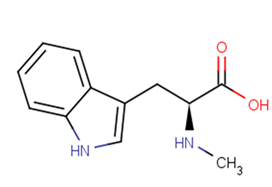
L-ABRINE
CAS No. 526-31-8
L-ABRINE ( L-(+)-Abrine;L-N-Methyltryptophan;N-α-Methyl-L-tryptophan )
Catalog No. M20460 CAS No. 526-31-8
L-ABRINE is a toxic protein found in the jequirity seed.can be used as a biomarker for abrin exposure.
Purity : >98% (HPLC)
 COA
COA
 Datasheet
Datasheet
 HNMR
HNMR
 HPLC
HPLC
 MSDS
MSDS
 Handing Instructions
Handing Instructions
| Size | Price / USD | Stock | Quantity |
| 50MG | 38 | In Stock |


|
| 100MG | 59 | In Stock |


|
| 200MG | Get Quote | In Stock |


|
| 500MG | Get Quote | In Stock |


|
| 1G | Get Quote | In Stock |


|
Biological Information
-
Product NameL-ABRINE
-
NoteResearch use only not for human use.
-
Brief DescriptionL-ABRINE is a toxic protein found in the jequirity seed.can be used as a biomarker for abrin exposure.
-
DescriptionL-ABRINE is a toxic protein found in the jequirity seed.can be used as a biomarker for abrin exposure.
-
SynonymsL-(+)-Abrine;L-N-Methyltryptophan;N-α-Methyl-L-tryptophan
-
PathwayOthers
-
TargetOther Targets
-
RecptorOthers
-
Research Area——
-
Indication——
Chemical Information
-
CAS Number526-31-8
-
Formula Weight218.25
-
Molecular FormulaC12H14N2O2
-
Purity>98% (HPLC)
-
SolubilityDMSO:2 mg/mL (9.16 mM)
-
SMILESCN[C@@H](Cc1c[nH]c2ccccc12)C(O)=O
-
Chemical NameN-Methyl-L-tryptophan
Shipping & Storage Information
-
Storage(-20℃)
-
ShippingWith Ice Pack
-
Stability≥ 2 years
Reference
1.Johnson R C Zhou Y Jain R et al. Quantification of L-Abrine in Human and Rat Urine: A Biomarker for the Toxin Abrin[J]. Journal of Analytical Toxicology 2009 33(2):77-84.
molnova catalog


related products
-
Cucurbit[8]uril
Cucurbit[8]uril is a potent, low toxicity and orally active supramolecular inducer of protein heterodimerization. Cucurbit[8]uril induces heterodimerization of methylviologen and naphthalene functionalized proteins. Cucurbit[8]uril can induce energy trans
-
Cyclo(Leu-Leu)
Cyclo(Leu-Leu) is an efficient supramolecular catalyst.
-
6-Methylflavone
6-Methylflavone is an activator of α1β2γ2L and α1β2 GABAA receptors.



 Cart
Cart
 sales@molnova.com
sales@molnova.com


